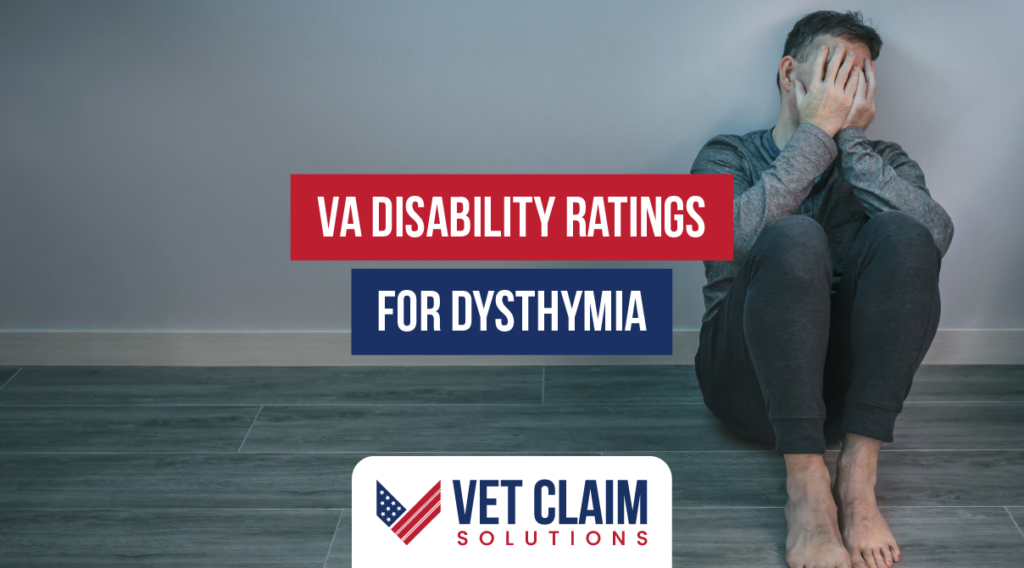Imagine wading through a fog that clings to your every step—this is the daily reality for veterans grappling with dysthymia. VA Disability Ratings for Dysthymia aren’t just numbers; they’re lifelines that can mean the difference between struggling in silence and getting much-needed support.
Pinning down these ratings can feel like trying to catch smoke with your bare hands, but it’s not all elusive shadows. There are concrete steps you can take—a map through the mist—to secure recognition from the VA.
You might know a bit about this process, maybe even faced its frustrations firsthand. Stick around because we’re diving deep into what makes or breaks these claims, revealing how you can cut through red tape and start making strides toward peace of mind.
VA Disability Ratings for Dysthymia

If you’ve ever felt like a gray cloud was following you long after your service, it might be more than just a rough patch. Veterans experiencing dysthymia know this all too well. It’s like the persistent danger of rain that never quite breaks—except it’s not about the weather; it’s your mood we’re talking about.
The VA rates mental health conditions including dysthymia with an understanding that symptoms can range from sadness to emptiness and may also include major depression episodes. The rating system acknowledges how these feelings can mess with everything—from brushing teeth to making decisions or even maintaining family relations.

Now, getting those benefits starts with matching VA disability ratings criteria—which is no walk in the park but definitely doable. They’ll look at social impairment caused by panic attacks or flattened affect, weigh out if there are issues with memory loss or suicidal ideation and consider whether daily tasks feel as complex as defusing a bomb due to reduced reliability and gross impairment.
Establishing Service Connection for Dysthymia
If you’re a veteran with dysthymia, getting VA benefits starts by showing the link between your condition and military service. Don’t fret; we have some insider advice to assist you in showing the connection between your dysthymia and military service.
Direct Service Connection Requirements
To get those benefits rolling in, first up is proving direct service connection. Think of it like this: Your time in the service should be the clear culprit behind your persistent depressive disorder. If symptoms kicked off while on active duty or within a calendar flip after discharge—boom. You’ve got what’s needed for that all-important direct service connection. But remember, just saying “I feel down” won’t cut it; solid medical evidence is key here.

Digging up that proof can feel like searching for lost treasure—but worth its weight in gold when done right. Gather everything from military records detailing an in-service event linked to depression va to current diagnosis documents and submit evidence till they can’t ignore it.
Secondary Service Connection Explained
Sometimes though, dysthymia sneaks up as an unwelcome plus-one to another condition—a secondary connection if you will. Maybe that back injury from jumping out of planes now has you grappling with chronic pain leading to mood swings worse than any rollercoaster ride? That’s where linking conditions such as these comes into play—and could bolster your claim even more.

The bottom line? Dotting every ‘i’ and crossing each ‘t’ with thorough documentation gives you fighting chance at winning over those rating boards because let’s face it—you deserve compensation for bravely serving our country while battling this invisible enemy.
Compensation and Pension Exam (C&P) for Dysthymia
The road to securing VA benefits for dysthymia starts with the pivotal C&P exam. This is where the VA gets up close and personal with your mental health, aiming to understand how deeply your mood disorder affects you. Think of it as a deep dive into your daily battles—the invisible weight you’ve been carrying since service.

During this critical exam, expect questions probing into occupational impairment caused by persistent depressive symptoms. They’re not just curious; they need to gauge if simple tasks have become herculean efforts or if socializing feels like scaling Mount Everest without gear.
It’s no secret that these exams are more than checking boxes—they can feel downright invasive. But remember, it’s about painting an accurate picture of how dysthymia has reshaped your life—whether that means memory loss during Monday meetings or panic attacks at peaceful picnics.
Common Secondary Conditions Associated with Dysthymia
Digging into the nitty-gritty of dysthymia, veterans know all too well that this mood disorder doesn’t march alone. It often brings buddies like chronic pain and eating disorders to the party. These secondary conditions can crank up the volume on your VA claim, making it a bit more complex but also giving you more angles for service connection.
Chronic Pain’s Role in Mental Health Ratings

You might say chronic pain is like that background noise you just can’t shake off—it impacts everything from your mental health condition to how VA rates mental health issues. Think about it; persistent discomfort could lead anyone down the path of depressive symptoms, worsening an existing case of dysthymia.
This tight-knit relationship means when assessing disability ratings for persistent depressive disorder or other related mental disorders, evidence of chronic pain will likely influence those numbers. That’s why linking these conditions together in your VA claim isn’t just smart—it’s crucial.
The Impact of Eating Disorders on Veterans with Dysthymia

Eating disorders are another heavy hitter as associated conditions affecting vets grappling with depression va ratings—because let’s face it: not much else affects both personal hygiene and social impairment quite like they do. If eating becomes a battlefield itself due to anxiety linked to military service or major depression kicking in post-service, voila. You’ve got yourself what we call a ‘secondary’ scenario.
If this resonates with you, highlighting co-occurring eating disorders during evaluation may give weight to establishing service connection indirectly through aggravated circumstances arising from active duty life stresses—a detail definitely worth munching over.
Tips for Navigating VA Claims Process with Dysthymia
Navigating the VA claims process can be like groping in a dark labyrinth without sight. But when it comes to dysthymia, knowing what cards to play can make all the difference.
Preparing Medical Documentation

To hit the ground running, get your medical documentation locked and loaded. This isn’t just about checking boxes; it’s proving that dysthymia isn’t just a word in your file—it’s affecting how you live every single day. Thorough records show exactly how symptoms like sadness or emptiness aren’t occasional guests; they’ve moved in and taken over your life.
You’ll want evidence so solid that there’s no room for doubt—think treatment records or doctor’s notes detailing medication regimens and therapy sessions. The more complete the story, the better VA can understand how deeply this mood disorder has dug its heels into your daily routine.
Understanding Schedular TDIU Benefits

Say hello to schedular TDIU benefits—a lifeline if persistent depressive disorder has tossed work off the table for you. If full-time employment feels as feasible as climbing Everest in flip-flops because of depression affect or flattened affect, these benefits could be game-changers.
This is where those key stats come alive: from personal hygiene challenges to memory loss shenanigans that leave complex commands feeling like hieroglyphics—every symptom counts towards painting a picture of gross impairment for the folks at VA. So don’t shy away from sharing even intermittent inability struggles—they matter big time here.
FAQs in Relation to Va Disability Ratings for Dysthymia
1. Does dysthymia count as a disability?
The VA considers dysthymia a disability if it’s linked to service and disrupts daily life.
2. What are the rates of dysthymia?
Dysthymia gets rated from 10% to 100%, reflecting how much it affects your work and living.
3. What is the severity scale for dysthymia?
The severity scale for dysthymia ranges from mild to severe, based on symptoms’ impact on function.
4. What category is dysthymia?
Dysthymia falls under mood disorders in the VA rating schedule for mental health conditions.
Conclusion
Understanding VA disability ratings for dysthymia is key. Remember, establishing a service connection paves the way to benefits. Whether it’s direct or secondary, evidence is your ally.
Dive into the details of each criterion and make sure you’ve got your bases covered. From documenting symptoms to demonstrating their impact on daily life—it all counts.
Face that C&P exam with confidence; it’s a critical piece of the puzzle in illustrating how dysthymia affects you. Chronic pain, eating disorders—these aren’t just side notes; they’re significant factors that can influence your rating.
Navigate wisely through this complex process. Prepare meticulously, understand every step and keep focused on what matters: getting support for persistent depressive struggles after serving our country bravely.


